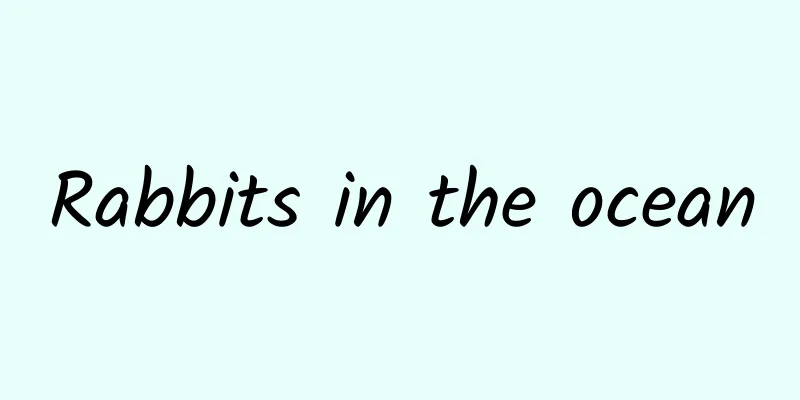Rabbits in the ocean

|
The Year of the Rabbit is here, and the streets and alleys are filled with various images of rabbits. In the ocean world, there is a little cutie whose name also contains the word "rabbit". It is today’s protagonist - the sea hare. - Aplysia - Image source: https://www.sohu.com/a/210836437_219830 Sea hares are a general term for organisms in the order Anaspidea of the subclass Opisthobranchia of the class Gastropoda, and are a member of the sea slug family. When they drag their soft bodies across the seafloor, the tentacles on their heads extend outward in an eight-shaped pattern, like snails on land. When they stop moving and rest, their tentacles stand upright like rabbit ears, hence the name sea hares. Sea slugs come in a variety of shapes, with the smallest being only about 2mm in size and the largest, the California sea slug, growing up to 75cm in length. Image source: https://www.guokr.com/article/ The California sea hare feeds mostly on red algae, and its body color is also red and pink. They are also excellent materials for neurobiology research, and they made great contributions to Eric Richard Kandel's Nobel Prize in Physiology and Medicine. As a mollusk, the sea hare has a soft and fragile body, which makes it not very aggressive. In addition, its poor elasticity and slow movement speed give it a natural disadvantage in resisting natural enemies. So how does the sea hare protect itself in the complex habitat of the seabed? Superb camouflage Bursatella leachii Blainville, 1817 Sea hares mostly feed on seaweed, which contains chlorophyll. Their bodies will change to the color of the seaweed they eat. So whenever sea hares arrive at a place, they will eat a lot of local seaweed. When the color changes to match that of the seaweed, they will hide in the seaweed to camouflage themselves, thus achieving the purpose of hiding. However, the camouflage of the sea hare is not as simple as imitating the appearance. The green sea hare living in the salt marshes of New England and Canada can photosynthesize and is the first animal discovered by humans to produce the plant pigment chlorophyll. The sea hare not only simulates the color of seaweed, but also "borrows" the identity of the seaweed producer. Chemical Warfare Master In addition to disguising themselves as seaweed or algae, sea slugs also have a very strong active defense mechanism - chemical defense. Aplysia has two glands: ink gland and opaline gland, which release different secretions. The ink gland secretes purple juice, while the opaline gland releases highly viscous white chemical components. These two substances mix in the mantle cavity of the sea slug, and through the contraction of the mantle muscles, purple viscous secretions are ejected. This is the first mechanism of chemical defense of the sea slug - smoke screen war affects vision. Image source: https://www.163.com/dy/article/D3PJREH50511LCGO.html If the sea slug is caught by a predator, the smoke screen can still work. The smoke screen contains a mixture of intermediates of lysine synthesis and hydrogen peroxide, which can suppress the senses of its predator and make the predator mistakenly think that the "smoke screen" is the real food. The irritation of the smoke itself will make the predator lose interest in hunting the sea slug, giving the sea slug a chance to escape. Unique mating method Sea hares are very special creatures. Due to the scarcity of individuals of the same size and their slow movements, mating is difficult, so sea hares are hermaphrodites, that is, a sea hare has two complete sets of male and female sexual organs. Except for a small number of sea hares who like to mate in pairs, most sea hares generally adopt two unique mating methods: mating chain Image credit: Aplysia dactylomela mating chain. PHOTO: Alison Miller. The vagina of the sea slug is located in the back center, and the external genitalia are on the right side of the head and body. When two sea slugs mate, they form a body position with one in front and one behind, connected head to tail. Therefore, more sea slugs can join in, forming a very long chain structure. If the "locomotive" meets the "tail", then a closed circle can even be formed. Sea fans After sea hares lay eggs, there is a jelly-like substance secreted by the albumen glands between the eggs, which sticks together into a ribbon-like egg cord, which contains tens of thousands of eggs, some of which can reach hundreds of meters. The beach can produce quite a lot of eggs, but because of the large loss (all eaten), only a small part can be hatched in the end. Sea hares are called "sea mealworms" in Fujian and Guangdong, and their egg cords are called "sea vermicelli", which is a very interesting local niche delicacy. Image source: https://www.163.com/dy/article/D3PJREH50511LCGO.html If we encounter sea slugs in the intertidal zone, remember to observe and interact with them in an appropriate and non-interfering manner. Image source: mt.sohu.com/20180531/n539348386.shtml Author: Fish Ball Expert Reviewer: Zhang Xiaofeng |
>>: Have you tried the two most classic candies for the Chinese New Year?
Recommend
Apple Watch actually has these little secrets?
Apple has always been reluctant to release detail...
How Xiaomi Enters Users' Homes from the Details of the Conference
On July 22, Xiaomi held its 2014 annual press con...
Tesla also has DLC: $300 to unlock heated seats, is it far from drawing cards and opening boxes?
Recently, a piece of news about the rear seat hea...
What should small and medium-sized entrepreneurs do during the epidemic?
Because of the coronavirus outbreak these days, t...
There are frequent layoffs in the industry. Is the Internet bubble about to burst?
2016 is coming to an end. When the first day of D...
The product logic behind the epidemic topics of Toutiao, WeChat, and Alipay
In January 2020, at the beginning of the Chinese ...
TopNews is a high imitation of the "Today's Headlines" client
Source code introduction: TopNews is a high imita...
Wetland Guardian, explore the magnificent transformation of the White Bone Peak!
This warm scene is a mother white-bone croaker fe...
Can eating snacks help you lose weight? The premise is that you have to do these 4 things!
Snacks include not only fruits, nuts and potato c...
Android P preview version hands-on experience: never get lost again
The Android P preview version is now available on...
Quantitative Trading Zero-Based Introduction Series-Master Python Data Analysis in 30 Days
Introduction to Quantitative Trading Zero-Based E...
A woman drank this tea for 2 years and the lining of her large intestine turned black! Many people use it to treat constipation
Expert of this article: Zhao Weitong, attending p...
Four ways to attract traffic to Zhihu in 2019!
Now more and more people trust Zhihu and not Baid...
The most comprehensive network operation solution analysis!
1. Competitive product analysis 1. Choose competi...
Will eating black fungus that has been soaked in the refrigerator for two days cause poisoning? Will keeping leafy vegetables in the refrigerator for 24 hours cause cancer? The truth is →
The refrigerator is one of the greatest invention...









